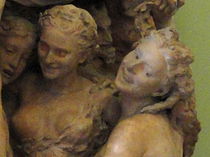Jean-Baptiste Carpeaux
| Jean-Baptiste Carpeaux | |
|---|---|

Illustration of Carpeaux by Étienne Bocourt in the Illustrated Sporting and Dramatic News, after his death. His Flore is below him, and Imperial France protecting Agriculture and Sciences above
|
|
| Born |
11 May 1827 Valenciennes, France |
| Died | 12 October 1875 (aged 48) Courbevoie, Paris, France |
| Nationality | French |
| Known for | Sculpture, painting |
| Notable work |
La Fontaine des quatre parties due monde Triomphe de Flore Le Génie de la Danse Le Pécheur napolitain La Frileuse |
| Patron(s) | Jean-Baptiste Foucart |
 |
|
|
|
Jean-Baptiste Carpeaux (11 May 1827 – 12 October 1875) was a French sculptor and painter during the Second Empire under Napoleon III.
Born in Valenciennes, Nord, son of a mason, his early studies were under François Rude. Carpeaux entered the École des Beaux-Arts in 1844 and won the Prix de Rome in 1854, and moving to Rome to find inspiration, he there studied the works of Michelangelo, Donatello and Verrocchio. Staying in Rome from 1854 to 1861, he obtained a taste for movement and spontaneity, which he joined with the great principles of baroque art. Carpeaux sought real life subjects in the streets and broke with the classical tradition.
Carpeaux debuted at the Salon in 1853 exhibiting La Soumission d'Abd-el-Kader al'Emperuer, a bas-relief in plaster that did not attract much attention. Carpeaux was an admirer of Napoléon III and followed him from city to city during Napoléon's official trip through the north of France. After initially not making any contact with the emperor, he finally succeeded in arranging a face-to-face encounter at Amiens where he managed to convince Napoléon to commission a marble statue that was to be carried out by a practitioner, Charles Romain Capellaro.
Carpeaux soon grew tired of academicism and became a wanderer on the streets of Rome. He spent free time admiring the frescoes of Michelangelo at the Sistine Chapel. Carpeaux said, "When an artist feels pale and cold, he runs to Michelangelo in order to warm himself, as with the rays of the sun".
While a student in Rome, Carpeaux submitted a plaster version of Pêcheur napolitain à la coquille, the Neapolitan Fisherboy, to the French Academy. He carved the marble version several years later, showing it in the Salon exhibition of 1863. It was purchased for Napoleon III's empress, Eugénie. The statue of the young smiling boy was very popular, and Carpeaux created a number of reproductions and variations in marble and bronze. There is a copy, for instance, in the Samuel H. Kress Collection in the National Gallery of Art in Washington, D.C. Some years later, he carved the Girl with a Shell, a very similar study.
...
Wikipedia
